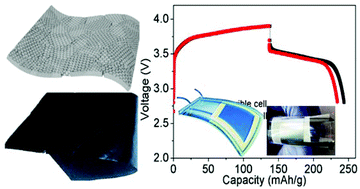Additive-free thick graphene film as an anode material for flexible lithium-ion batteries†
Abstract
This work demonstrates a simple route to develop mechanically flexible electrodes for Li-ion batteries (LIBs) that are usable as lightweight effective conducting networks for both cathodes and anodes. Removing electrochemically dead elements, such as binders, conducting agents and metallic current collectors, from the battery components will allow remarkable progress in this area. To investigate the feasibility of using thick, additive-free graphene films as anodes for flexible LIBs, we have synthesized and tested thick, additive-free, freestanding graphene films as anodes, first in a coin cell and further in a flexible full cell. As an anode material in a half cell, it showed a discharge capacity of about 350 mA h g−1 and maintained nearly this capacity over 50 cycles at various current rates. This film was also tested as an anode material in a full cell with a LiCoO2 cathode and showed good electrochemical performance. Because the graphene-based flexible film showed good performance in half- and full coin cells, we used this film as a flexible anode for flexible LIBs. No conducting agent or binder was used in the anode side, which helped in realizing the flexible LIBs. Using this, we demonstrate a thin, lightweight and flexible lithium ion battery with good electrochemical performance in both its flat and bent states.

- This article is part of the themed collection: Graphene-based Energy Devices

 Please wait while we load your content...
Please wait while we load your content...